section 9 SUZUKI SX4 2006 1.G Service Service Manual
[x] Cancel search | Manufacturer: SUZUKI, Model Year: 2006, Model line: SX4, Model: SUZUKI SX4 2006 1.GPages: 1556, PDF Size: 37.31 MB
Page 101 of 1556
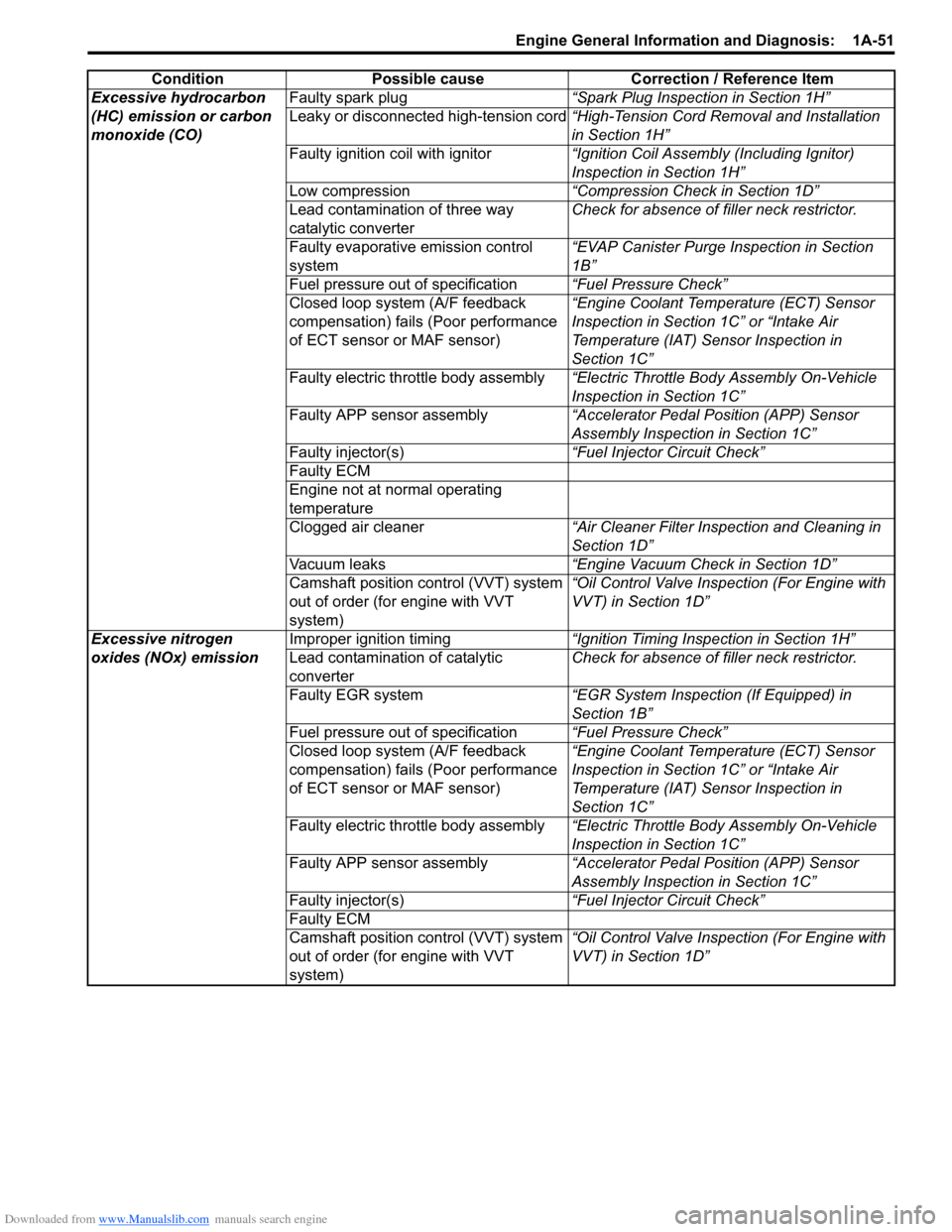
Downloaded from www.Manualslib.com manuals search engine Engine General Information and Diagnosis: 1A-51
Excessive hydrocarbon
(HC) emission or carbon
monoxide (CO)Faulty spark plug“Spark Plug Inspection in Section 1H”
Leaky or disconnected high-tension cord“High-Tension Cord Removal and Installation
in Section 1H”
Faulty ignition coil with ignitor“Ignition Coil Assembly (Including Ignitor)
Inspection in Section 1H”
Low compression“Compression Check in Section 1D”
Lead contamination of three way
catalytic converterCheck for absence of filler neck restrictor.
Faulty evaporative emission control
system“EVAP Canister Purge Inspection in Section
1B”
Fuel pressure out of specification“Fuel Pressure Check”
Closed loop system (A/F feedback
compensation) fails (Poor performance
of ECT sensor or MAF sensor)“Engine Coolant Temperature (ECT) Sensor
Inspection in Section 1C” or “Intake Air
Temperature (IAT) Sensor Inspection in
Section 1C”
Faulty electric throttle body assembly“Electric Throttle Body Assembly On-Vehicle
Inspection in Section 1C”
Faulty APP sensor assembly“Accelerator Pedal Position (APP) Sensor
Assembly Inspection in Section 1C”
Faulty injector(s)“Fuel Injector Circuit Check”
Faulty ECM
Engine not at normal operating
temperature
Clogged air cleaner“Air Cleaner Filter Inspection and Cleaning in
Section 1D”
Vacuum leaks“Engine Vacuum Check in Section 1D”
Camshaft position control (VVT) system
out of order (for engine with VVT
system)“Oil Control Valve Inspection (For Engine with
VVT) in Section 1D”
Excessive nitrogen
oxides (NOx) emissionImproper ignition timing“Ignition Timing Inspection in Section 1H”
Lead contamination of catalytic
converterCheck for absence of filler neck restrictor.
Faulty EGR system“EGR System Inspection (If Equipped) in
Section 1B”
Fuel pressure out of specification“Fuel Pressure Check”
Closed loop system (A/F feedback
compensation) fails (Poor performance
of ECT sensor or MAF sensor)“Engine Coolant Temperature (ECT) Sensor
Inspection in Section 1C” or “Intake Air
Temperature (IAT) Sensor Inspection in
Section 1C”
Faulty electric throttle body assembly“Electric Throttle Body Assembly On-Vehicle
Inspection in Section 1C”
Faulty APP sensor assembly“Accelerator Pedal Position (APP) Sensor
Assembly Inspection in Section 1C”
Faulty injector(s)“Fuel Injector Circuit Check”
Faulty ECM
Camshaft position control (VVT) system
out of order (for engine with VVT
system)“Oil Control Valve Inspection (For Engine with
VVT) in Section 1D” Condition Possible cause Correction / Reference Item
Page 104 of 1556

Downloaded from www.Manualslib.com manuals search engine 1A-54 Engine General Information and Diagnosis:
Malfunction Indicator Lamp Remains ON after Engine StartsS6RW0D1104012
Wiring Diagram
Refer to “Malfunction Indicator Lamp Does Not Come ON with Ignition Switch ON and Engine Stop (but Engine Can
Be Started)”.
Circuit Description
When the ignition switch is turned ON, ECM causes the main relay to turn ON (close the contact point). Then, ECM
being supplied with the main power, transmits indication ON signal of malfunction indicator lamp (MIL) to combination
meter in order to turn MIL ON. And then, combination meter turns MIL ON. When the engine starts to run and no
malfunction is detected in the system, ECM transmits MIL indication OFF signal to combination meter in order to turn
MIL OFF. And then, combination meter turns MIL OFF, but if a malfunction was or is detected, MIL remains ON even
when the engine is running.
Troubleshooting
NOTE
• Before performed trouble shooting, be sure to read the “Precautions of ECM Circuit Inspection”.
• When measuring circuit voltage, resistance and/or pulse signal at ECM connector, connect the
special tool to ECM and/or the ECM connectors referring to “Inspection of ECM and Its Circuits”.
Step Action Yes No
1DTC check
1) Start engine and recheck DTC of ECM and TCM (for A/T
model) while engine running.
Is there any DTC(s)?Go to Step 2 of “Engine
and Emission Control
System Check”, Step 2
of “A/T System Check in
Section 5A”.Go to Step 2.
2CAN communication line circuit check
1) Check CAN communication line circuit between control
modules for open, short, high resistance and
connections referring to Step 5 to 10 under
“Troubleshooting for Communication Error with Scan
Tool Using CAN”.
Is circuit in good condition?Substitute a known-
good combination meter
and recheck. If MIL still
remains ON, substitute
a known-good ECM and
recheck.Repair or replace CAN
communication circuit.
Page 107 of 1556
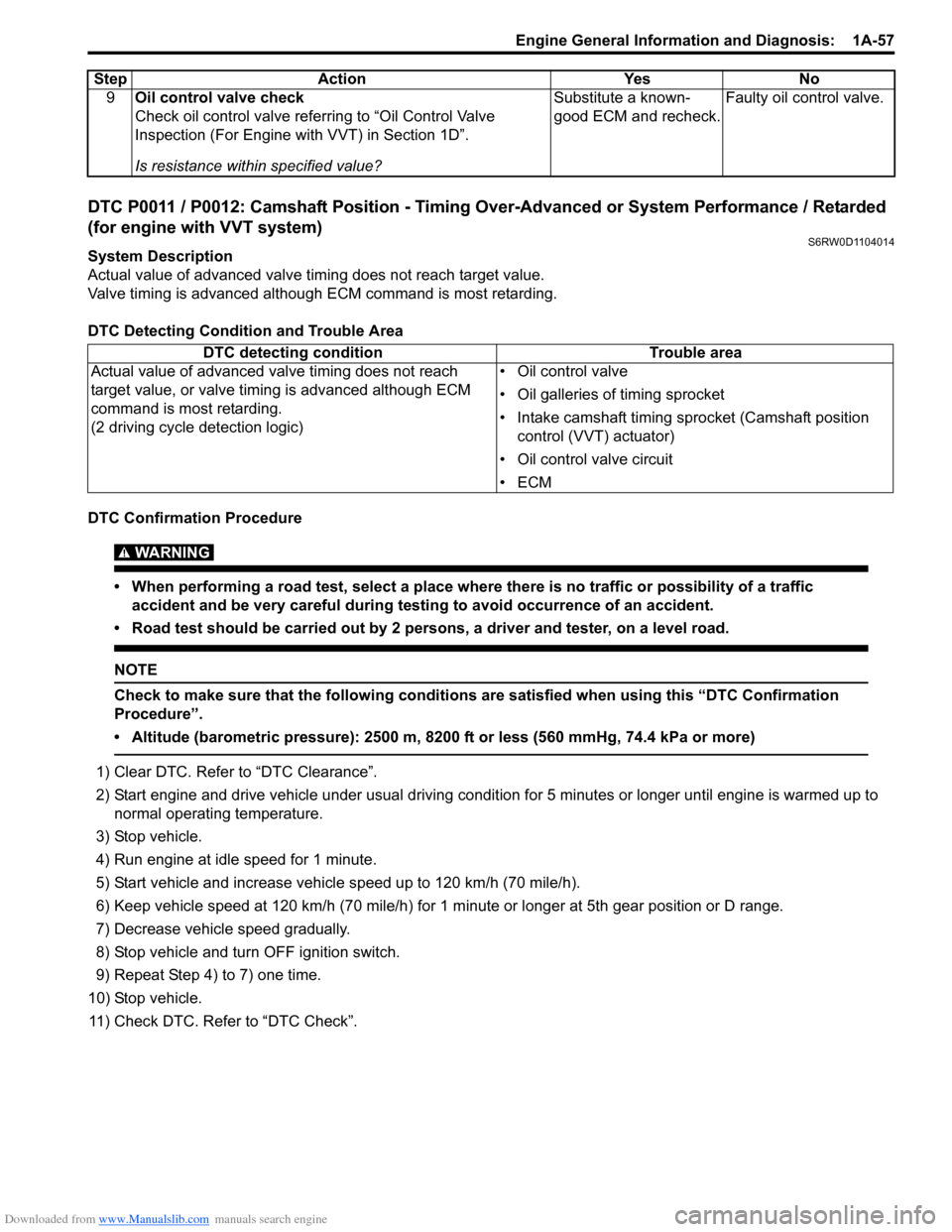
Downloaded from www.Manualslib.com manuals search engine Engine General Information and Diagnosis: 1A-57
DTC P0011 / P0012: Camshaft Position - Timing Over-Advanced or System Performance / Retarded
(for engine with VVT system)
S6RW0D1104014
System Description
Actual value of advanced valve timing does not reach target value.
Valve timing is advanced although ECM command is most retarding.
DTC Detecting Condition and Trouble Area
DTC Confirmation Procedure
WARNING!
• When performing a road test, select a place where there is no traffic or possibility of a traffic
accident and be very careful during testing to avoid occurrence of an accident.
• Road test should be carried out by 2 persons, a driver and tester, on a level road.
NOTE
Check to make sure that the following conditions are satisfied when using this “DTC Confirmation
Procedure”.
• Altitude (barometric pressure): 2500 m, 8200 ft or less (560 mmHg, 74.4 kPa or more)
1) Clear DTC. Refer to “DTC Clearance”.
2) Start engine and drive vehicle under usual driving condition for 5 minutes or longer until engine is warmed up to
normal operating temperature.
3) Stop vehicle.
4) Run engine at idle speed for 1 minute.
5) Start vehicle and increase vehicle speed up to 120 km/h (70 mile/h).
6) Keep vehicle speed at 120 km/h (70 mile/h) for 1 minute or longer at 5th gear position or D range.
7) Decrease vehicle speed gradually.
8) Stop vehicle and turn OFF ignition switch.
9) Repeat Step 4) to 7) one time.
10) Stop vehicle.
11) Check DTC. Refer to “DTC Check”.9Oil control valve check
Check oil control valve referring to “Oil Control Valve
Inspection (For Engine with VVT) in Section 1D”.
Is resistance within specified value?Substitute a known-
good ECM and recheck.Faulty oil control valve. Step Action Yes No
DTC detecting condition Trouble area
Actual value of advanced valve timing does not reach
target value, or valve timing is advanced although ECM
command is most retarding.
(2 driving cycle detection logic)• Oil control valve
• Oil galleries of timing sprocket
• Intake camshaft timing sprocket (Camshaft position
control (VVT) actuator)
• Oil control valve circuit
•ECM
Page 108 of 1556
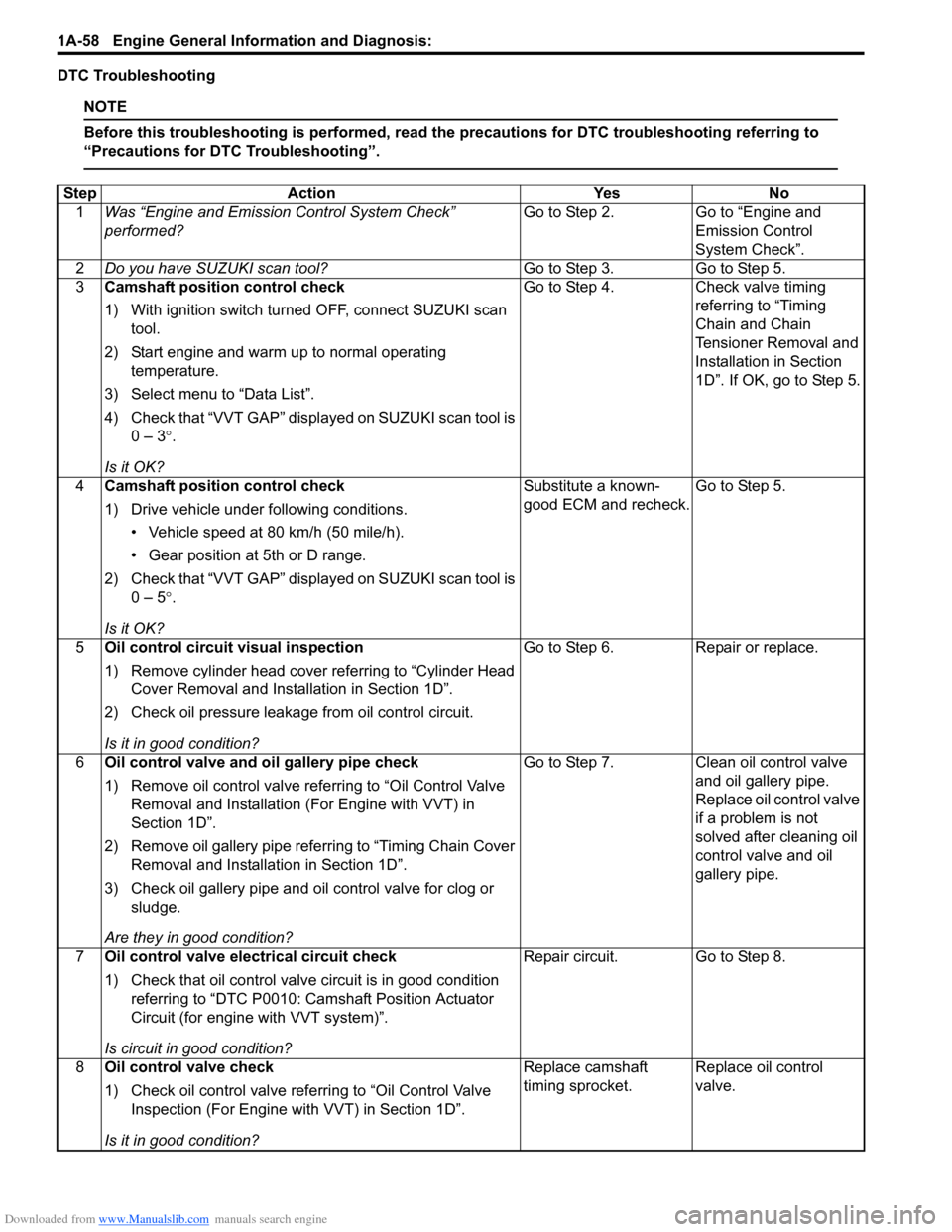
Downloaded from www.Manualslib.com manuals search engine 1A-58 Engine General Information and Diagnosis:
DTC Troubleshooting
NOTE
Before this troubleshooting is performed, read the precautions for DTC troubleshooting referring to
“Precautions for DTC Troubleshooting”.
Step Action Yes No
1Was “Engine and Emission Control System Check”
performed?Go to Step 2. Go to “Engine and
Emission Control
System Check”.
2Do you have SUZUKI scan tool?Go to Step 3. Go to Step 5.
3Camshaft position control check
1) With ignition switch turned OFF, connect SUZUKI scan
tool.
2) Start engine and warm up to normal operating
temperature.
3) Select menu to “Data List”.
4) Check that “VVT GAP” displayed on SUZUKI scan tool is
0 – 3°.
Is it OK?Go to Step 4. Check valve timing
referring to “Timing
Chain and Chain
Tensioner Removal and
Installation in Section
1D”. If OK, go to Step 5.
4Camshaft position control check
1) Drive vehicle under following conditions.
• Vehicle speed at 80 km/h (50 mile/h).
• Gear position at 5th or D range.
2) Check that “VVT GAP” displayed on SUZUKI scan tool is
0 – 5°.
Is it OK?Substitute a known-
good ECM and recheck.Go to Step 5.
5Oil control circuit visual inspection
1) Remove cylinder head cover referring to “Cylinder Head
Cover Removal and Installation in Section 1D”.
2) Check oil pressure leakage from oil control circuit.
Is it in good condition?Go to Step 6. Repair or replace.
6Oil control valve and oil gallery pipe check
1) Remove oil control valve referring to “Oil Control Valve
Removal and Installation (For Engine with VVT) in
Section 1D”.
2) Remove oil gallery pipe referring to “Timing Chain Cover
Removal and Installation in Section 1D”.
3) Check oil gallery pipe and oil control valve for clog or
sludge.
Are they in good condition?Go to Step 7. Clean oil control valve
and oil gallery pipe.
Replace oil control valve
if a problem is not
solved after cleaning oil
control valve and oil
gallery pipe.
7Oil control valve electrical circuit check
1) Check that oil control valve circuit is in good condition
referring to “DTC P0010: Camshaft Position Actuator
Circuit (for engine with VVT system)”.
Is circuit in good condition?Repair circuit. Go to Step 8.
8Oil control valve check
1) Check oil control valve referring to “Oil Control Valve
Inspection (For Engine with VVT) in Section 1D”.
Is it in good condition?Replace camshaft
timing sprocket.Replace oil control
valve.
Page 110 of 1556

Downloaded from www.Manualslib.com manuals search engine 1A-60 Engine General Information and Diagnosis:
2HO2S-1 heater power circuit check
1) Disconnect connector from HO2S-1 with ignition switch
turned OFF.
2) Check for proper connection to HO2S-1 at “BLK/WHT”
and “BLK/RED” wire terminals.
3) If wire and connection are OK, measure voltage
between “BLK/WHT” wire terminal and engine ground
with ignition switch turned ON.
Is voltage over 10 V?Go to Step 3. “BLK/WHT” wire is open
circuit or shorted to
ground circuit.
3HO2S-1 heater power circuit check
1) Disconnect connectors from ECM with ignition switch
turned OFF.
2) Measure resistance between “BLK/WHT” wire terminal
of HO2S-1 connector and “E01-29” terminal of ECM
connector.
Is resistance below 5
Ω?Go to Step 4. “BLK/WHT” wire is high
resistance circuit.
4HO2S-1 heater drive circuit check
1) Measure resistance between “C01-46” terminal of ECM
connector and vehicle body ground.
Is resistance infinity?Go to Step 5. “BLK/RED” wire is
shorted to ground
circuit.
5HO2S-1 heater drive circuit check
1) Turn ON ignition switch.
2) Measure voltage between “C01-46” terminal of ECM
connector and vehicle body ground.
Is voltage 0 V?Go to Step 6. “BLK/RED” wire is
shorted to power circuit.
6HO2S-1 heater drive circuit check
1) Connect connector to HO2S-1 with ignition switch turned
OFF.
2) Turn ON ignition switch.
3) Measure voltage between “C01-46” terminal of ECM
connector and vehicle body ground with connector
disconnected from ECM.
Is voltage over 10 V?Go to Step 7. “BLK/RED” wire is open
circuit.
7HO2S-1 heater check
1) Disconnect HO2S-1 connector with ignition switch
turned OFF.
2) Check HO2S-1 heater resistance referring to “Heated
Oxygen Sensor (HO2S-1 and HO2S-2) Heater On-
Vehicle Inspection (If Equipped) in Section 1C”.
Is resistance within specified value range?Go to Step 8. Replace HO2S-1.
8HO2S-1 heater power circuit check
1) Connect connector to HO2S-1 with ignition switch turned
OFF.
2) Measure resistance between “E01-29” and “C01-46”
terminals of ECM connector.
It resistance below 12
Ω?HO2S-1 heater circuit is
OK.
Substitute a known-
good ECM and recheck.“BLK/WHT”, “BLK/RED”
and / or “BLK” wire is
high resistance circuit. Step Action Yes No
Page 112 of 1556

Downloaded from www.Manualslib.com manuals search engine 1A-62 Engine General Information and Diagnosis:
2HO2S-2 heater power circuit check
1) Disconnect connector from HO2S-2 with ignition switch
turned OFF.
2) Check for proper connection to HO2S-2 at “BLK/WHT”
and “RED/BLU” wire terminals.
3) If wire and connection are OK, measure voltage
between “BLK/WHT” wire terminal of HO2S-2 connector
and engine ground with ignition switch turned ON.
Is voltage over 10 V?Go to Step 3. “BLK/WHT” wire is open
circuit or shorted to
ground circuit.
3HO2S-2 heater power circuit check
1) Disconnect connectors from ECM with ignition switch
turned OFF.
2) Measure resistance between “BLK/WHT” wire terminal
of HO2S-2 connector and “E01-29” terminal wire of ECM
connector.
Is resistance below 5
Ω?Go to Step 4. “BLK/WHT” wire is high
resistance circuit.
4HO2S-2 heater drive circuit check
1) Measure resistance between “RED/BLU” wire terminal of
HO2S-2 connector and vehicle body ground.
Is resistance infinity?Go to Step 5. “RED/BLU” wire is
shorted to ground
circuit.
5HO2S-2 heater drive circuit check
1) Turn ON ignition switch.
2) Measure voltage between “RED/BLU” wire terminal of
HO2S-2 connector and vehicle body ground.
Is voltage 0 V?Go to Step 6. “RED/BLU” wire is
shorted to power circuit.
6HO2S-2 heater drive circuit check
1) Connect connector to HO2S-2 with ignition switch turned
OFF.
2) Turn ON ignition switch.
3) Measure voltage between “C01-47” terminal of
disconnected ECM connector and vehicle body ground.
Is voltage over 10 V?Go to Step 7. “RED/BLU” wire is open
circuit.
7HO2S-2 heater check
1) Disconnect HO2S-2 connector with ignition switch
turned OFF.
2) Check HO2S-2 heater resistance referring to “Heated
Oxygen Sensor (HO2S-1 and HO2S-2) Heater On-
Vehicle Inspection (If Equipped) in Section 1C”.
Is resistance within specified value?Go to Step 8. Replace HO2S-2.
8HO2S-2 heater power circuit check
1) Connect connector to HO2S-2 with ignition switch turned
OFF.
2) Measure resistance between “E01-29” and “C01-47”
terminals of ECM connector.
Is resistance below 30
Ω?HO2S-2 heater circuit is
OK. Substitute a known-
good ECM and recheck.“RED/BLU” wire is high
resistance circuit. Step Action Yes No
Page 115 of 1556
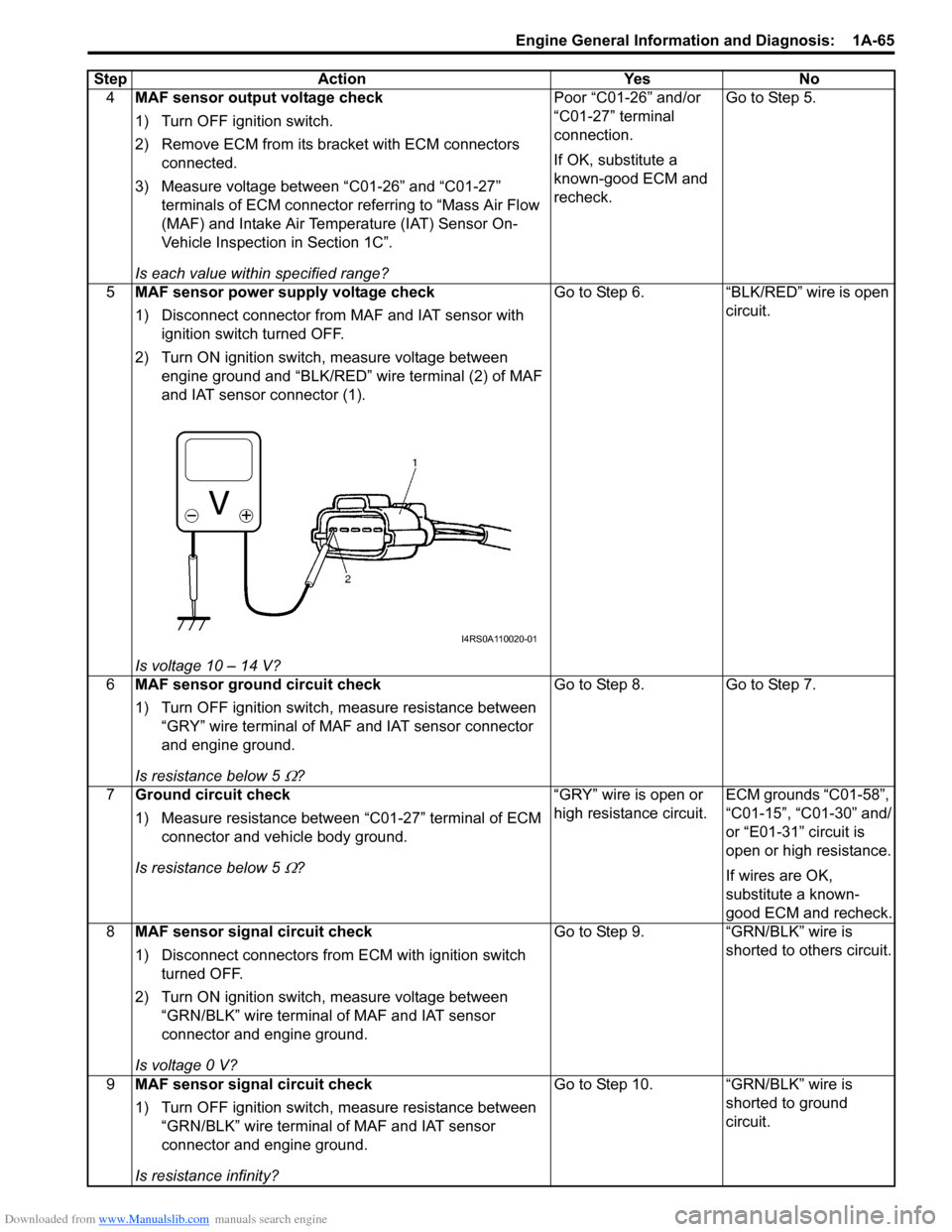
Downloaded from www.Manualslib.com manuals search engine Engine General Information and Diagnosis: 1A-65
4MAF sensor output voltage check
1) Turn OFF ignition switch.
2) Remove ECM from its bracket with ECM connectors
connected.
3) Measure voltage between “C01-26” and “C01-27”
terminals of ECM connector referring to “Mass Air Flow
(MAF) and Intake Air Temperature (IAT) Sensor On-
Vehicle Inspection in Section 1C”.
Is each value within specified range?Poor “C01-26” and/or
“C01-27” terminal
connection.
If OK, substitute a
known-good ECM and
recheck.Go to Step 5.
5MAF sensor power supply voltage check
1) Disconnect connector from MAF and IAT sensor with
ignition switch turned OFF.
2) Turn ON ignition switch, measure voltage between
engine ground and “BLK/RED” wire terminal (2) of MAF
and IAT sensor connector (1).
Is voltage 10 – 14 V?Go to Step 6. “BLK/RED” wire is open
circuit.
6MAF sensor ground circuit check
1) Turn OFF ignition switch, measure resistance between
“GRY” wire terminal of MAF and IAT sensor connector
and engine ground.
Is resistance below 5
Ω?Go to Step 8. Go to Step 7.
7Ground circuit check
1) Measure resistance between “C01-27” terminal of ECM
connector and vehicle body ground.
Is resistance below 5
Ω?“GRY” wire is open or
high resistance circuit.ECM grounds “C01-58”,
“C01-15”, “C01-30” and/
or “E01-31” circuit is
open or high resistance.
If wires are OK,
substitute a known-
good ECM and recheck.
8MAF sensor signal circuit check
1) Disconnect connectors from ECM with ignition switch
turned OFF.
2) Turn ON ignition switch, measure voltage between
“GRN/BLK” wire terminal of MAF and IAT sensor
connector and engine ground.
Is voltage 0 V?Go to Step 9. “GRN/BLK” wire is
shorted to others circuit.
9MAF sensor signal circuit check
1) Turn OFF ignition switch, measure resistance between
“GRN/BLK” wire terminal of MAF and IAT sensor
connector and engine ground.
Is resistance infinity?Go to Step 10. “GRN/BLK” wire is
shorted to ground
circuit. Step Action Yes No
I4RS0A110020-01
Page 116 of 1556
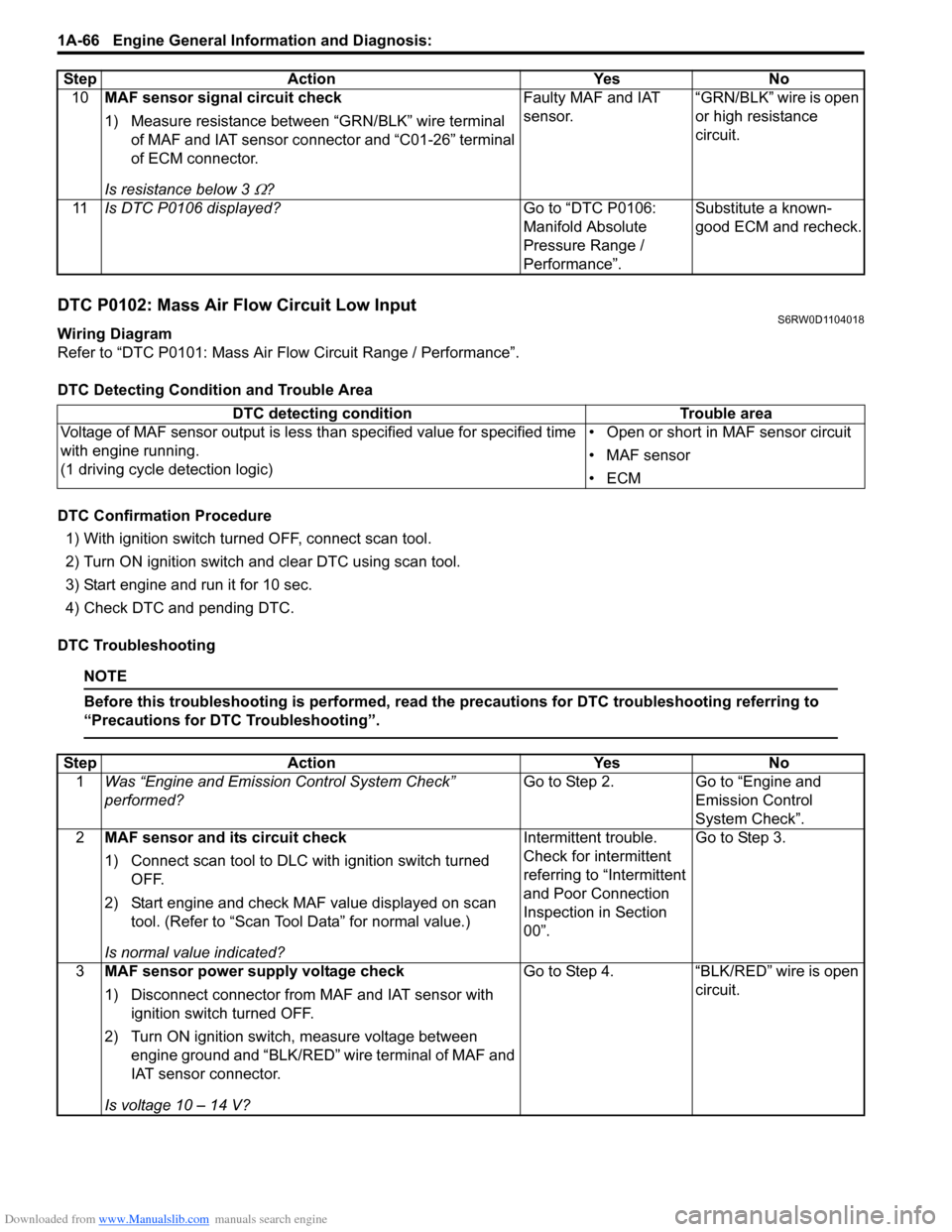
Downloaded from www.Manualslib.com manuals search engine 1A-66 Engine General Information and Diagnosis:
DTC P0102: Mass Air Flow Circuit Low InputS6RW0D1104018
Wiring Diagram
Refer to “DTC P0101: Mass Air Flow Circuit Range / Performance”.
DTC Detecting Condition and Trouble Area
DTC Confirmation Procedure
1) With ignition switch turned OFF, connect scan tool.
2) Turn ON ignition switch and clear DTC using scan tool.
3) Start engine and run it for 10 sec.
4) Check DTC and pending DTC.
DTC Troubleshooting
NOTE
Before this troubleshooting is performed, read the precautions for DTC troubleshooting referring to
“Precautions for DTC Troubleshooting”.
10MAF sensor signal circuit check
1) Measure resistance between “GRN/BLK” wire terminal
of MAF and IAT sensor connector and “C01-26” terminal
of ECM connector.
Is resistance below 3
Ω?Faulty MAF and IAT
sensor.“GRN/BLK” wire is open
or high resistance
circuit.
11Is DTC P0106 displayed?Go to “DTC P0106:
Manifold Absolute
Pressure Range /
Performance”.Substitute a known-
good ECM and recheck. Step Action Yes No
DTC detecting condition Trouble area
Voltage of MAF sensor output is less than specified value for specified time
with engine running.
(1 driving cycle detection logic)• Open or short in MAF sensor circuit
• MAF sensor
•ECM
Step Action Yes No
1Was “Engine and Emission Control System Check”
performed?Go to Step 2. Go to “Engine and
Emission Control
System Check”.
2MAF sensor and its circuit check
1) Connect scan tool to DLC with ignition switch turned
OFF.
2) Start engine and check MAF value displayed on scan
tool. (Refer to “Scan Tool Data” for normal value.)
Is normal value indicated?Intermittent trouble.
Check for intermittent
referring to “Intermittent
and Poor Connection
Inspection in Section
00”.Go to Step 3.
3MAF sensor power supply voltage check
1) Disconnect connector from MAF and IAT sensor with
ignition switch turned OFF.
2) Turn ON ignition switch, measure voltage between
engine ground and “BLK/RED” wire terminal of MAF and
IAT sensor connector.
Is voltage 10 – 14 V?Go to Step 4. “BLK/RED” wire is open
circuit.
Page 117 of 1556

Downloaded from www.Manualslib.com manuals search engine Engine General Information and Diagnosis: 1A-67
DTC P0103: Mass Air Flow Circuit High InputS6RW0D1104019
Wiring Diagram
Refer to “DTC P0101: Mass Air Flow Circuit Range / Performance”.
DTC Detecting Condition and Trouble Area
DTC Confirmation Procedure
1) With ignition switch turned OFF, connect scan tool.
2) Turn ON ignition switch and clear DTC using scan tool.4MAF sensor ground circuit check
1) Turn OFF ignition switch, measure resistance between
“GRY” wire terminal of MAF and IAT sensor connector
and engine ground.
Is resistance below 5
Ω?Go to Step 6. Go to Step 5.
5Ground circuit check
1) Remove ECM from its bracket with ECM connectors
connected.
2) Measure resistance between “C01-27” terminal of ECM
connector and engine ground.
Is resistance below 5
Ω?“GRY” wire is open or
high resistance circuit.ECM grounds “C01-58”,
“C01-15”, “C01-30” and/
or “E01-31” circuit is
open or high resistance.
If wires are OK,
substitute a known-
good ECM and recheck.
6MAF sensor signal circuit check
1) Disconnect connectors from ECM with ignition switch
turned OFF.
2) Measure voltage between “GRN/BLK” wire terminal of
MAF and IAT sensor connector and engine ground with
ignition switch turned ON.
Is voltage 0 V?Go to Step 7. “GRN/BLK” wire is
shorted to other circuit.
7MAF sensor signal circuit check
1) Measure resistance between “GRN/BLK” wire terminal
of MAF and IAT sensor connector and engine ground
with ignition switch turned OFF.
Is resistance infinity?Go to Step 8. “GRN/BLK” wire is
shorted to ground
circuit.
8MAF sensor signal circuit check
1) Measure resistance between “GRN/BLK” wire terminal
of MAF and IAT sensor connector and “C01-26” terminal
of ECM connector.
Is resistance below 3
Ω?Go to Step 9. “GRN/BLK” wire is open
or high resistance
circuit.
9MAF sensor output signal check
1) Connect connectors to MAF and IAT sensor and ECM
with ignition switch turned OFF.
2) Measure voltage between “C01-26” and “C01-27”
terminals of ECM connector referring to “Mass Air Flow
(MAF) and Intake Air Temperature (IAT) Sensor On-
Vehicle Inspection in Section 1C”.
Is each value within specified range?Substitute a known-
good ECM and recheck.Faulty MAF and IAT
sensor. Step Action Yes No
DTC detecting condition Trouble area
Voltage of MAF sensor output is more than specified value for specified time
with engine running.
(1 driving cycle detection logic)• Open or short in MAF sensor circuit
• MAF sensor
•ECM
Page 118 of 1556

Downloaded from www.Manualslib.com manuals search engine 1A-68 Engine General Information and Diagnosis:
3) Start engine and run it for 10 sec.
4) Check DTC and pending DTC.
DTC Troubleshooting
NOTE
Before this troubleshooting is performed, read the precautions for DTC troubleshooting referring to
“Precautions for DTC Troubleshooting”.
Step Action Yes No
1Was “Engine and Emission Control System Check”
performed?Go to Step 2. Go to “Engine and
Emission Control
System Check”.
2MAF sensor and its circuit check
1) Connect scan tool to DLC with ignition switch turned
OFF.
2) Start engine and check MAF value displayed on scan
tool. (Refer to “Scan Tool Data” for normal value.)
Is normal value indicated?Intermittent trouble.
Check for intermittent
referring to “Intermittent
and Poor Connection
Inspection in Section
00”.Go to Step 3.
3MAF sensor power supply voltage check
1) Disconnect connector from MAF and IAT sensor with
ignition switch tuned OFF.
2) Turn ON ignition switch, measure voltage between
engine ground and “BLK/RED” wire terminal of MAF and
IAT sensor connector.
Is voltage 10 – 14 V?Go to Step 4. “BLK/RED” wire is open
circuit.
4MAF sensor ground circuit check
1) Turn OFF ignition switch, measure resistance between
“GRY” wire terminal of MAF and IAT sensor connector
and engine ground.
Is resistance below 5
Ω?Go to Step 6. Go to Step 5.
5Ground circuit check
1) Remove ECM from its bracket with ECM connectors
connected.
2) Measure resistance between “C01-27” terminal of ECM
connector and engine ground.
Is resistance below 5
Ω?“GRY” wire is open or
high resistance circuit.ECM grounds “C01-58”,
“C01-15”, “C01-30” and/
or “E01-31” circuit are
open or high resistance.
If wires are OK,
substitute a known-
good ECM and recheck.
6MAF sensor signal circuit check
1) Disconnect connectors from ECM with ignition switch
turned OFF.
2) Measure voltage between “GRY/BLK” wire terminal of
MAF and IAT sensor connector and engine ground.
Is voltage 0 V?Go to Step 7. “GRY/BLK” wire is
shorted to other circuit.
7MAF sensor output signal check
1) Connect connector to MAF and IAT sensor and ECM
with ignition switch turned OFF.
2) Measure voltage between “C01-26” and “C01-27”
terminal of ECM connector referring to “Mass Air Flow
(MAF) and Intake Air Temperature (IAT) Sensor On-
Vehicle Inspection in Section 1C”.
Is each value within specified range?Substitute a known-
good ECM and recheck.Faulty MAF and IAT
sensor.